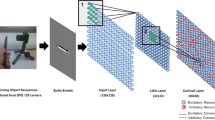Abstract
There is now abundant evidence that the structure of the mammalian visual cortex is not innately determined but can be altered by visual experiences during a certain period at an early age. A model based on the evidence is proposed that will explain some aspects of the developmental process in the visual cortex. The model self-organizingly forms “a simple cell” which responds to bars and edges of a certains orientation and retinal position. The total system of the model corresponds to “a hyper column” which contains a complete cycle of orientational selectiviy. The model has the following three original points. i) “A hyper column” is finally formed in the model. ii) Most of the cells do not have orientation selectivity in the initial state. iii) It is hypothesized that the orientation continuity of the hyper column is caused by similar orientations of successive input stimuli. The results of computer simulation show that the model has the expected performance.
Similar content being viewed by others
References
Barlow, H.B.: Visual experience and cortical development. Nature 258, 199–204 (1975)
Blakemore, C., Cooper, G.F.: Development of the brain depends on the visual environment. Nature (Lond.) 228, 477–478 (1970)
Blakemore, C., Van Sluyters, R.C.: Innate and environmental factors in the development of the kitten's visual cortex. J. Physiol. 248, 663–716 (1975)
Deutsch, S.: Conjectures on the mammalian neuron networks for visual pattern recognition. IEEE Trans., SSC-2, 81–85 (1966)
Fukushima, K.: Visual feature extraction by a multinetwork of analog threshold elements. IEEE Trans., SSC-5, 322–333 (1969)
Fukushima, K.: A model of associative memory in the brain. Kybernetik 12, 58–63 (1973)
Gorssberg, S.: On the development of feature detectors in the visual cortex with applications to learning and reaction-diffusion systems. Biol. Cybernetics 21, 145–159 (1976)
Hall, R., Yau, S.S.: The distribution of orientation of optimal stimuli for cells of striate cortex. Biol. Cybernetics 21, 113–120 (1976)
Hirsch, H.V.B., Spinelli, D.N.: Visual experience modifies distribution of horizontally and vertically oriented receptive fields in cats. Science 168, 869–871 (1970)
Hiwatashi, K., Osada, S.: A simulation of receptive fields in the vertebrate visual system by electronic circuits. Jap. J. Med. Electron. Biol. Eng. 5, 376–383 (1967)
Hubel, D.H., Wiesel, T.N.: Receptive fields, binocular interaction, and functional architecture in the cat's visual cortex. J. Physiol. (Lond.) 160, 106–154 (1962)
Hubel, D.H., Wiesel, T.N.: Receptive fields of cells in striate cortex of very young, visually inexperienced kittens. J. Neurophysiol. 26, 994–1002 (1963a)
Hubel, D.H., Wiesel, T.N.: Shape and arrangement of columns in cat's striate cortex. J. Physiol. 165, 559–568 (1963b)
Hubel, D.H., Wiesel, T.N.: Receptive fields and functional architecture of monkey striate cortex. J. Physiol. (Lond.) 195, 215–243 (1968)
Hubel, D.H., Wiesel, T.N.: Sequence regularity and geometry of orientation columns in the monkey striate cortex. J. Comp. Neurol. 158, 267–294 (1974a)
Hubel, D.H., Wiesel, T.N.: Uniformity of monkey striate cortex: a parallel relationship between field size, scatter and magnification factor. J. Comp. Neurol. 158, 295–306 (1974b)
Lorente de No, R.: The cerebral cortex: Architecture, intracortical connections, and motor projections in physiology and nervous system. New York: Oxford University Press 1938
Marr, D.: A theory for cerebral neocortex. Proc. Roy. Soc. Lond. B 176, 161–234 (1970)
Nagano, T.: Some considerations on learning algorithms. Trans. Inst. Electron. Comm. Eng. Jap. 57-C, 661–667 (1974)
Nass, M.M., Cooper, L.N.: A theory for the development of feature detecting cells in visual cortex. Biol. Cybernetics 19, 1–18 (1975)
Pettigrew, J.D., Freeman, R.D.: Visual experience without lines: effect on developing cortical neurons. Science 182, 599–601 (1973)
Shepherd, G.M.: The synaptic organization of the brain. New York: Oxford University Press, 1974
Von der Malsburg, C.: Self-organization of orientation sensitive cells in the striate cortex. Kybernetik 14, 85–100 (1973)
Wiesel, T.N., Hubel, D.H.: Single-cell response in striate cortex of kittens deprived of vision on one eye. J. Neurophysiol. 26, 1004–1017 (1963)
Author information
Authors and Affiliations
Rights and permissions
About this article
Cite this article
Nagano, T. A model of visual development. Biol. Cybernetics 26, 45–52 (1977). https://doi.org/10.1007/BF00363991
Received:
Issue Date:
DOI: https://doi.org/10.1007/BF00363991




